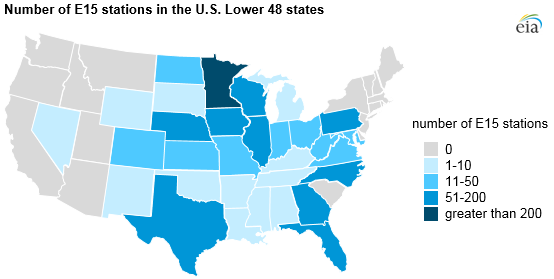On May 31, 2019, the U.S. Environmental Protection Agency (EPA) issued a final rule allowing the year-round sale of motor gasoline blends containing up to 15% fuel ethanol, or E15. The ruling increases the availability of E15 blends in the United States, which are currently sold at more than 1,800 retail fuel stations across 31 states, according to Growth Energy, a trade association that represents producers and supporters of fuel ethanol.
Most motor gasoline fuel sold in the United States contains up to 10% ethanol, referred to as E10. Ethanol acts as a fuel oxygenate to create a cleaner burning fuel and to raise the octane rating of motor gasoline. Higher ethanol blends such as E15 may sell for lower prices relative to E10 when the price of ethanol is lower than gasoline blendstock on an energy equivalent basis. Presently, E15 is sold at a 3- to 10-cent/gallon price discount relative to E10, or 87 octane blends, in most markets.

In 2011, EPA granted a partial waiver under the Clean Air Act (CAA) to allow the use of E15 in motor vehicles manufactured in model year 2001 or later. Among other restrictions, the partial waiver did not change existing regulations that prohibited the sale of E15 in conventional fuel markets during the summer driving season, defined as June 1 to September 15 of each year. During the summer, EPA is more restrictive on the volatility of motor gasoline introduced into the market in order to limit evaporative emissions that contribute to ground-level ozone.
The expanded waivers for E15 were announced in October 2018, which will help to increase domestic energy production and to support the domestic agriculture industry. The final rule updated EPA’s interpretation of the statute. By considering E10 and E15 as substantially similar, the new interpretation effectively opened the opportunity for year-round E15 sales in most markets.
Although new fueling stations typically install fueling equipment that is E15 compliant, older stations may need to install new equipment to accommodate the slightly more corrosive nature of E15 gasoline. Retrofits may be cost-prohibitive if they require equipment, such as underground storage tanks, to be replaced.
Certain incentives could offset the cost of expanding fuel options to E15. The U.S. Department of Agriculture’s Biofuels Infrastructure Partnership program awarded $100 million in grants to increase consumption of higher fuel ethanol blends during fiscal year 2015. State-level programs, such as the Iowa Renewable Fuels Infrastructure Program, have also encouraged station owners to offer E15 and higher ethanol blends.
E15 fuel is often marketed as an unleaded fuel with an octane rating of 88. According to Growth Energy, more than 1,800 stations offer E15. Minnesota is home to the largest number of E15 stations with 303 stations, followed by Wisconsin (197), Iowa (187), and Florida (185).
EIA does not collect E15 sales data, and state-level information is limited. The Minnesota Commerce Department reported 59.4 million gallons of E15 sales in the state in 2018, nearly triple 2017 levels. According to an Iowa Department of Revenue report, state E15 sales were about 35.5 million gallons of E15 in 2018, almost a 30% increase over the previous year. In 2018, E15 was sold at about 15% and 10% of retail fueling stations in Minnesota and Iowa, respectively. On a national level, however, less than 2% of retail fueling stations offer E15.
Principal contributor: Steve Hanson

Follow us on social media: